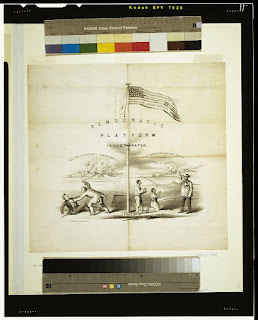For some reason (or no reason, I suppose), it never occurred to me that Preston Brooks actually needed that cane he brought with him when he entered the Senate chamber in 1856. If you had asked me, I would probably have said that it was either an affectation - more of a walking stick than a cane - or Brooks had brought it specifically to assault Charles Sumner.
Well, you learn something new every day. According to Shearer Davis Bowman, Brooks used a cane because of an old dueling injury - an injury inflicted by none other than our friend Louis Trezevant Wigfall.
In the early 1840s, on an island in the Savannah River, Wigfall and Preston Brooks had engaged in a duel. Wigfall took a bullet in the thigh but shot Brooks through the hip. Brooks used a cane for the rest of his life, pressing the walking stick in 1856 as a weapon with which to beat Charles Sumner on the floor of the Senate.
About the illustration, entitled Democratic Platform Illustrated (1856):
Another attack on the 1856 Democratic platform as pro-South and proslavery. The Buchanan-Breckenridge ticket is reviled on the basis of recent developments occurring during the outgoing Pierce administration. In the center of the picture is a flagstaff bearing an American flag inscribed "Buchanan & Breckenridge. Modern Democracy." To its base are chained two slaves (right)--a man and a woman. The woman kneels before an overseer with a whip and pistol in his pocket, and asks, "Is this Democracy?" The overseer declares, "We will subdue you." In the background one of Cuba's coastal towns burns and is fired upon by a ship. The scene probably refers to expressed Democratic ambitions to annex Cuba for the expansion of American slave territory. The phrase "A due regard for our just rights in the Gulf of Mexico" appears above the burning town. A similar scene of conflagration, "Squatter sovereignty demonstrated," appears in the left background. Here a settlement in Kansas burns and its inhabitants are driven away by armed marauders. Reference is to atrocities committed in the wake of the Kansas-Nebraska Act of May 1854, which was endorsed by the Democratic platform. The act provided for dividing the Nebraska territory into two parts, each later to be admitted into the Union as either slave or free, as decided in each case by popular (or "squatter") sovereignty. The measure ushered in a bloody struggle between proslavery and antislavery settlers over control of Kansas. The antislavery town of Lawrence, Kansas, was invaded and sacked by a proslavery posse on May 21, 1856. In the left foreground is Preston S. Brooks's May 22 attack on Charles Sumner in Congress. (See "Arguments of the Chivalry," no. 1856-1.)

No comments:
Post a Comment